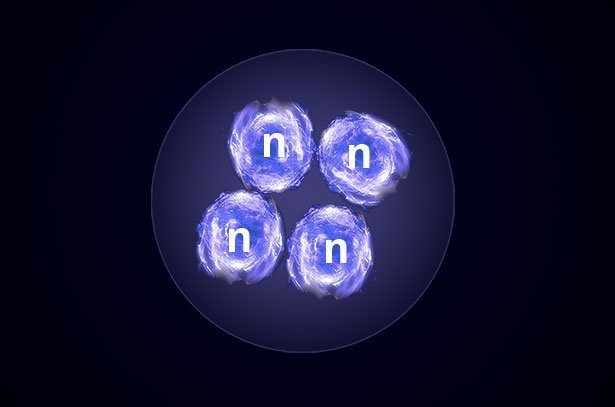In the heart of atomic nuclei, neutrons are bound together with protons through incredibly strong interactions. While this is a common phenomenon in most atoms, particles made entirely of neutrons are exceedingly rare. Recently, however, physicists have reported a groundbreaking discovery: the observation of a tetraneutron, a particle made up of four neutrons.

What is a Tetraneutron?
The only stable system we know that consists almost entirely of neutrons is a neutron star, where these particles are held together by gravity. However, on a subatomic scale, gravity’s influence is negligible compared to the strong nuclear force that binds particles together. This means that a particle composed solely of neutrons must be held together by the powerful nuclear force.
Understanding how this force operates in such a particle has been challenging. The theoretical framework for particles containing three or more neutrons has been elusive, making experimental research crucial.
The Life of a Neutron
A free neutron can exist for nearly 15 minutes before decaying into a proton, an electron, and a neutrino. In 2012, physicists discovered the dineutron—a particle made of two neutrons—with a lifetime of about (10^{-22}) seconds. Modern theories of strong interactions suggest that systems containing three or more neutrons should not be possible, and there has been no experimental evidence supporting their existence—until now.
The Search for Tetraneutrons
The quest for the tetraneutron, a particle made of four neutrons, has been ongoing since the 1960s. While several physicists have claimed to have found such particles, the results have not been precise enough to gain widespread acceptance in the scientific community.
This situation has recently changed. The SAMURAI collaboration, involving physicists from 23 countries, has successfully observed tetraneutrons with a significant level of confidence. The experiment took place at the Radioactive Isotope Beam Factory (RIBF), operated by the RIKEN Nishina Center and the Nuclear Study Center (CNS) at the University of Tokyo.
How Was the Tetraneutron Detected?
In the experiment, scientists fired a series of helium nuclei containing many neutrons at a liquid hydrogen target. Helium nuclei, the most abundant isotope containing only two neutrons, were chosen for this purpose.
When these helium nuclei collided with the hydrogen target, they interacted with the protons in the hydrogen atoms, producing one proton, a helium nucleus (also known as an alpha particle), and the tetraneutron.
Detecting tetraneutrons is challenging because they have no charge, making them much harder to spot compared to charged particles like protons and alpha particles. Researchers focused on studying the reactions of the proton and alpha particles, though some neutrons escaping from the tetraneutron were also detected.
By measuring the energy and momentum of the proton and alpha particles using the SAMURAI spectrometer, scientists gathered information about the tetraneutron. They found that the mass of this newly discovered particle is slightly higher—about 0.05% more—than the combined mass of four neutrons. The particle’s lifetime is around (4 \times 10^{-22}) seconds. These findings align with some previous experimental results, bolstering confidence in the discovery.
Theoretical Implications
However, the experimental data does not fit well with current theories of nuclear forces, suggesting that more complex theories are needed to understand the physics of tetraneutrons.
According to the study’s authors, future experiments exploring different reaction mechanisms and potentially detecting tetraneutrons more directly will provide deeper insights into the nature of these enigmatic particles.
This discovery opens up exciting new avenues in the study of nuclear physics, challenging existing theories and inviting further exploration into the world of subatomic particles.
Reference
- Tetraneutron finally found, Advanced Science News
- Observation of a correlated free four-neutron system, Nature (2022)